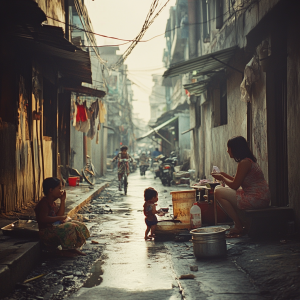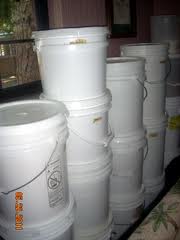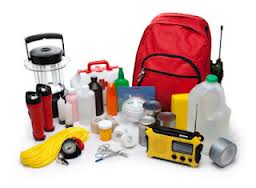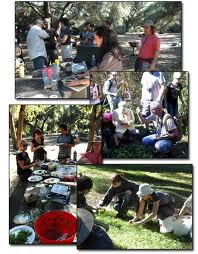
Manilla street scene in the Philippines
Over the course of the next 99 days, as a part of the “100 Days of Prepping” series we’re doing, I hope to take you on a little more scenic, and often missed journey of a self-sufficient lifestyle. I hope to take you to some of my favorite “spots” on this journey and most memorable and lasting impressions I’ve received along the way that have transformed all that I am from the simple position of “food storage” to the more advanced position of living a peaceful and very fulfilling self-sufficient life.
From “Food Storage” to “Emergency Preparedness”:
When I first learned about “prepping” it was in the context of having “food storage” on hand and then graduated towards an “emergency preparedness” mindset. Growing up I always saw yellow bags of whole wheat and buckets and cans of sugar, powdered milk, and dried beans tucked away throughout the house. I was mostly raised by my single mother with 3 other brothers and a sister. I remember Mom gathering us kids together on a few occasions and trying to teach us why we needed to have this unpleasant sounding “food storage” in the first place? We moved around a lot growing up and I always dreaded having to move those dusty buckets and bags with us wherever we went. Mom’s explanation for the need of “food storage” brought on even more questions to me as she shared with us the warnings in the scriptures to be “prepared” as well as some natural disaster events. To an 8 year old, the biblical scenarios weren’t fathomable to me, but I took them on faith nonetheless; but the natural disaster scenarios got me curious.
tucked away throughout the house. I was mostly raised by my single mother with 3 other brothers and a sister. I remember Mom gathering us kids together on a few occasions and trying to teach us why we needed to have this unpleasant sounding “food storage” in the first place? We moved around a lot growing up and I always dreaded having to move those dusty buckets and bags with us wherever we went. Mom’s explanation for the need of “food storage” brought on even more questions to me as she shared with us the warnings in the scriptures to be “prepared” as well as some natural disaster events. To an 8 year old, the biblical scenarios weren’t fathomable to me, but I took them on faith nonetheless; but the natural disaster scenarios got me curious.
One summer found us living in a small rural town in Idaho called Menan. I remember one night sitting at the dinner table and listening to the adults discuss how they were still trying to recover in their croplands and cattle from the devastating effects of the Teton Dam breaking just 2 years prior. Our hostess that evening was able to weave detailed and descriptive tales of what people endured during that crisis to the point that I had suddenly been introduced to a world in which a natural disaster could dramatically alter the peaceful life in that valley. I heard tales of diapers and baby formula being in high demand—“as valuable as gold”; entire towns being destroyed, townspeople crafting roughshod water vessels in order to check on and assist neighbors, the devastating loss of entire crops and over 15,000 heads of cattle with total damage at that time estimated to be $2 billion. Not only did the area residents have to dig themselves out of a mosquito infested scenario, but they had to bounce back from having absolutely nothing left but the clothes on their back and each other.
In spite of this moment of education, I was so foolish. I still remember feeling a bit slighted when we had to eat home-canned goods for our meals, and had to hand grind the oats or make buckwheat flour in the mornings and had to drink the milk from cows and eat eggs from chickens instead of buying the REAL food at the stores and restaurants. I remember Mom trying to tell me that what I learned that summer about food and where it originally comes from would mean everything to me someday.
“72 Hour Kits”:
When I turned 12, I got to attend a lot of church activities with other girls my age. One night we had an activity in which we made simple “72 Hour Kits”. I hadn’t heard the term previously but learned that it was something that you grabbed when you had to leave your house suddenly in the case of an emergency such as a house fire or an immediate evacuation plan. I was pretty impressed with MY kit as I remembered to include some of my favorite records, books, curling iron, nylons (cause I finally got to wear nylons and small heels when I turned 12), and hair ribbons.  What I didn’t know though is that 2 weeks later we were going to be putting our 72 hour kits to the test during a 5 days girls camping trip. We had an event in which we were required to live out of our 72 Hour Kit that we had made for one day of the camping trip—and oh, by the way, we were going to have to take it with us on a long, mountainous hike. Needless to say, after the first mile I wasn’t too thrilled with my idea of packing hardback books and that bulky curling iron. Worse though, I had no idea how to use the little stove and had to borrow matches to start the fire. That night I crunched on raw ramen noodles because I only had a little bit of water left in my canteen. I discovered that week that camping really wasn’t my favorite past time and that I needed to think of a heck of a lot more practical and needful items to go in my kits. But most importantly, 72 Hour Kits had only a miniscule amount of possibilities in life in which I’d need one, but the principle of a 72 Hour Kit could certainly be carried over into every other part of my life. Vacations always have need of those “just in case” items; what’s packed in a box in the trunk of the car just might save a life someday; and a woman’s purse has the ability to make all the difference between a great time or a disaster. *grin* Once I started to see more applications in my life for “72 Hour Kits”—or at least the principle behind them, I was able to be more open to the next step in the progressive journey of preparedness.
What I didn’t know though is that 2 weeks later we were going to be putting our 72 hour kits to the test during a 5 days girls camping trip. We had an event in which we were required to live out of our 72 Hour Kit that we had made for one day of the camping trip—and oh, by the way, we were going to have to take it with us on a long, mountainous hike. Needless to say, after the first mile I wasn’t too thrilled with my idea of packing hardback books and that bulky curling iron. Worse though, I had no idea how to use the little stove and had to borrow matches to start the fire. That night I crunched on raw ramen noodles because I only had a little bit of water left in my canteen. I discovered that week that camping really wasn’t my favorite past time and that I needed to think of a heck of a lot more practical and needful items to go in my kits. But most importantly, 72 Hour Kits had only a miniscule amount of possibilities in life in which I’d need one, but the principle of a 72 Hour Kit could certainly be carried over into every other part of my life. Vacations always have need of those “just in case” items; what’s packed in a box in the trunk of the car just might save a life someday; and a woman’s purse has the ability to make all the difference between a great time or a disaster. *grin* Once I started to see more applications in my life for “72 Hour Kits”—or at least the principle behind them, I was able to be more open to the next step in the progressive journey of preparedness.
“Self-Reliance”:
At the age of 21 I had decided that I wanted to serve a mission for my church. Part of that meant that I would be willing to go wherever it was that I was asked. My letter came and informed me that I would be going to the Quezon City, Philippines Mission, but that instead of serving a proselytizing mission, I was to serve in the capacity of a “Welfare Sister.” I confess. I cried tears of dismay when I got that letter. I hated the heat and humidity; I didn’t want to be a “Welfare Sister”—whatever that was, and I didn’t want to go somewhere dirty and without grocery stores and restaurants. As always, He had a big surprise in store for me that He delivered very patiently and with an abundance of love. As a result of my serving in the capacity of a “Welfare Sister” I learned how to break down and replicate so many of the parts of my life that I had taken for granted. I got to learn SO much and then teach what I learned to obscure, rural communities spread out along the Luzon Island. Topics such as water filtration, dental care, first response medical treatment, sanitation, exercise and nutrition, all wrapped up beautifully in Faith in God. But the most important  thing that I had the privilege of learning was beauty of being self-reliant. I learned over and over again that it was only those persons who lived in a self-reliant fashion that had the ability to help and serve others. Learning to create a modest income for themselves instead of hoping to be selected for work each day provided a much more stable home; learning how to barter talents and time for essentials that others had plenty of; and for me, learning the true meaning of the word “welfare”—the term that brought me to disappointing, selfish tears when I first heard it, had provided me with an invaluable life lesson as its true meaning unfolded for me in the Philippines—a meaning so drastically different than sense of entitlement or Godless independence that I had understood it to be before my missionary service. Ultimately, I grew to treasure my role as a “Welfare Sister” because I learned that “welfare” was literally the Gospel of Jesus Christ in action. Just as important, I learned that self-reliance, when combined with a person’s core values and belief systems, brought a nearly unexplainable amount of joy and peace and that a person who’s willing to stand self-reliant has the makings of a great and loving leader. What a joy it was for me to watch the growth of those around me as they got to experience that development and witness a change in their own lives. It was NOT rare in which I had the privilege to watch and marvel at how one single person, who first mentally and spiritually chose to step outside of their abject poverty and scarcity around them only to discover a very real and lasting lifestyle of abundance and peace later which lead to others in their community to have a little faith and follow suit. *contented sigh* Wow…just wow…
thing that I had the privilege of learning was beauty of being self-reliant. I learned over and over again that it was only those persons who lived in a self-reliant fashion that had the ability to help and serve others. Learning to create a modest income for themselves instead of hoping to be selected for work each day provided a much more stable home; learning how to barter talents and time for essentials that others had plenty of; and for me, learning the true meaning of the word “welfare”—the term that brought me to disappointing, selfish tears when I first heard it, had provided me with an invaluable life lesson as its true meaning unfolded for me in the Philippines—a meaning so drastically different than sense of entitlement or Godless independence that I had understood it to be before my missionary service. Ultimately, I grew to treasure my role as a “Welfare Sister” because I learned that “welfare” was literally the Gospel of Jesus Christ in action. Just as important, I learned that self-reliance, when combined with a person’s core values and belief systems, brought a nearly unexplainable amount of joy and peace and that a person who’s willing to stand self-reliant has the makings of a great and loving leader. What a joy it was for me to watch the growth of those around me as they got to experience that development and witness a change in their own lives. It was NOT rare in which I had the privilege to watch and marvel at how one single person, who first mentally and spiritually chose to step outside of their abject poverty and scarcity around them only to discover a very real and lasting lifestyle of abundance and peace later which lead to others in their community to have a little faith and follow suit. *contented sigh* Wow…just wow…
This idea of self-reliance not only had the ability of changing one’s physical environment but it changed their hearts. When both parties in a marriage would apply the principle of self-reliance on themselves and started taking responsibility for their own happiness and sense of self-worth instead of relying on the other’s approval and adoration for their esteem, the relationships would always change into something amazing and worth having forever and ever.
(Continued in Part 2)



9 Comments
Suzie · January 7, 2013 at 2:27 pm
This is beautiful, Kellene.
Dorothy (the perky gramma) · January 7, 2013 at 3:07 pm
Wow! Thank you for sharing and reminding us that mission trips are able to teach us very valuable lessons.
One memorable mission trip I went on was to the inner city of Kingston, Jamaica. We were building shelters for pregnant women who lived on the streets.
Before the trip I complained because I had a couch with one leg and held up by three cans of creamed corn. When I returned I vowed never to complain again, for I had three cans of creamed corn and a couch.
I am preparing for a journey to Cambodia this year. We are going to a restoration home for girls ages 3-18 who have been rescued from sexual slavery.
We are so blessed and often don’t recognize it. I’ve learned a lot from all my mission trips. Today I will reflect back on those experiences again.
Kellene Bishop · January 7, 2013 at 10:22 pm
Thank you for sharing this, Perky!
NYC Girl · January 7, 2013 at 3:37 pm
LOVE THIS!
Gail · January 8, 2013 at 2:03 am
I am enjoying learning about your journey to preparedness. The comment ” I learned over and over again that it was only those persons who lived in a self-reliant fashion that had the ability to help and serve others.” really has struck me. I am looking forward to the rest of our 99 days, thank you for doing this.
Rani · January 8, 2013 at 3:15 am
Love your insightful ending.
Ken · January 8, 2013 at 5:41 pm
THANK YOU!!!! Your words helped me greatly today. God Bless.
Mary · January 13, 2013 at 6:04 pm
Thank you for sharing all of this with us, Kellene. I thoroughly enjoy your writings. As an 80 year old great grandmother living in a house with three male relatives (only one of whom is a “prepper” like me) I think I will find your “journey” a badly needed inspiration. I am so looking forward to the rest of it. God bless!
Mary Sisson · June 10, 2013 at 2:03 pm
First of all I LOVE your blog. I have learned so much from you and learning everyday. I take in a lot of info from your blog and links to learn to be more self sufficant.
I have bought my Excalibur Dehydrator, and 40 lbs of chicken from Zaycon, Foodsaver vacuum sealer. I was wondering how long should my diced or sliced dehydrated chicken last sealed in bags vs jars?
I also ordered a 50 lb box of pork belly from my grocer butcher to make my own bacon and will be keeping a diary of that.
I have stocked up on bags everytime Foodsaver has a sale. I buy canning jars about everytime I go to the store, bought Tattlers lids by the dozen from eBay. I was even given dozens of 1/2 gal. jars from a friend cleaning out her garage. I am blessed and I’m spreading the word.
Comments are closed.